Unit 6 Survival Understanding ideas 课件(共64张)-2025-2026学年外研版(2019)选择性必修第二册
文档属性
| 名称 | Unit 6 Survival Understanding ideas 课件(共64张)-2025-2026学年外研版(2019)选择性必修第二册 | 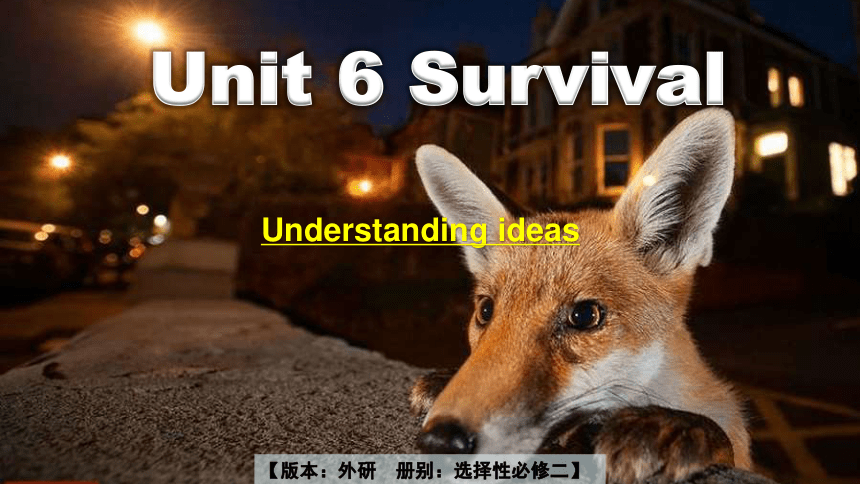 | |
| 格式 | pptx | ||
| 文件大小 | 64.7MB | ||
| 资源类型 | 教案 | ||
| 版本资源 | 外研版(2019) | ||
| 科目 | 英语 | ||
| 更新时间 | 2025-06-16 23:15:56 | ||
图片预览

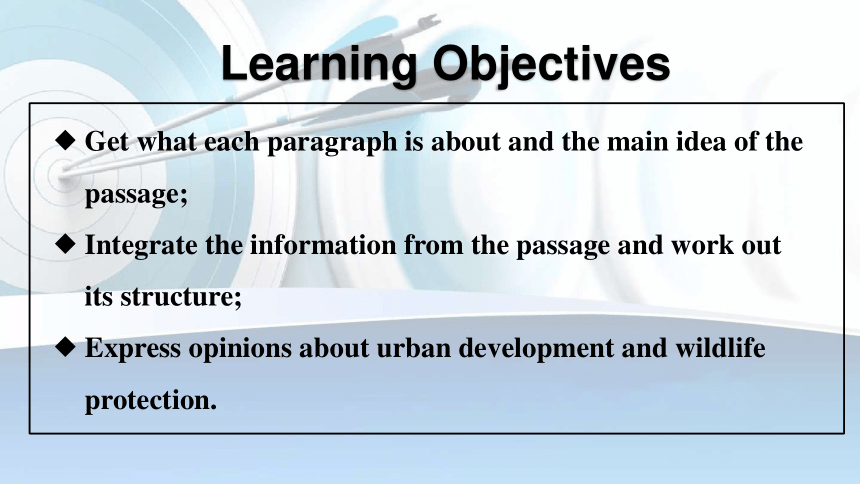
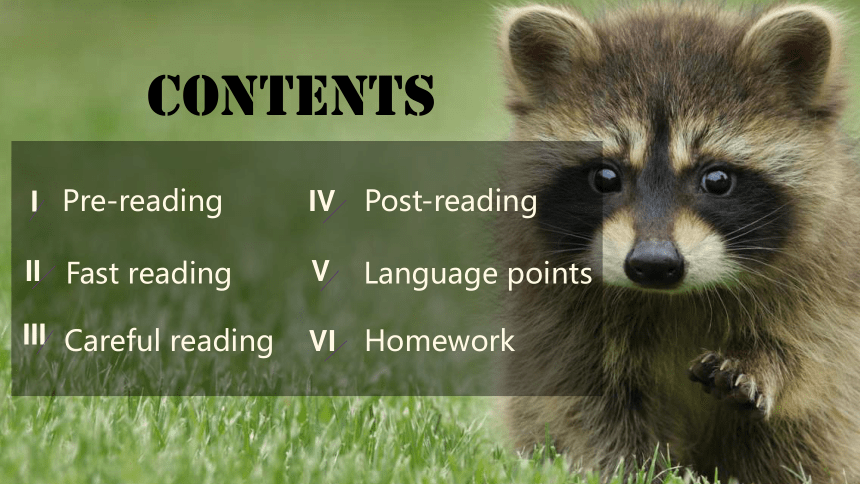
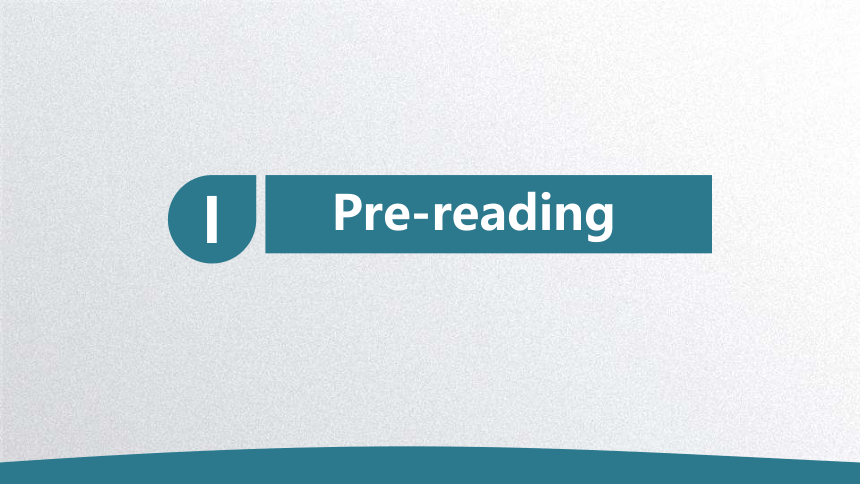
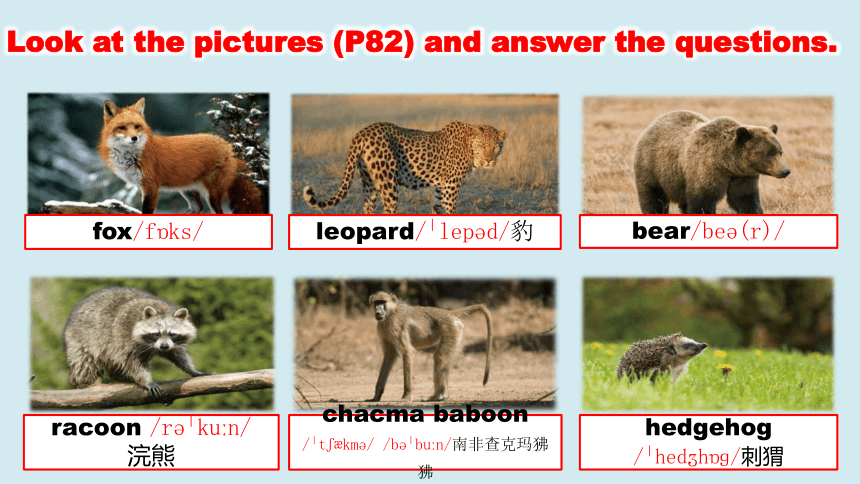
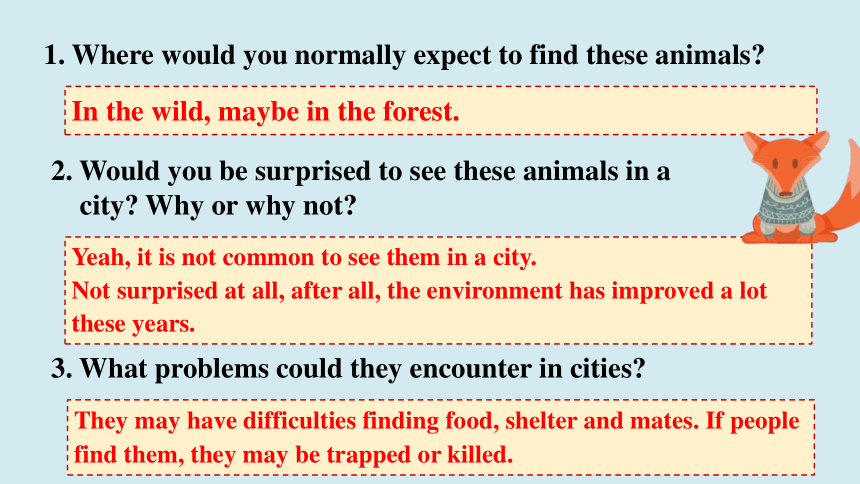
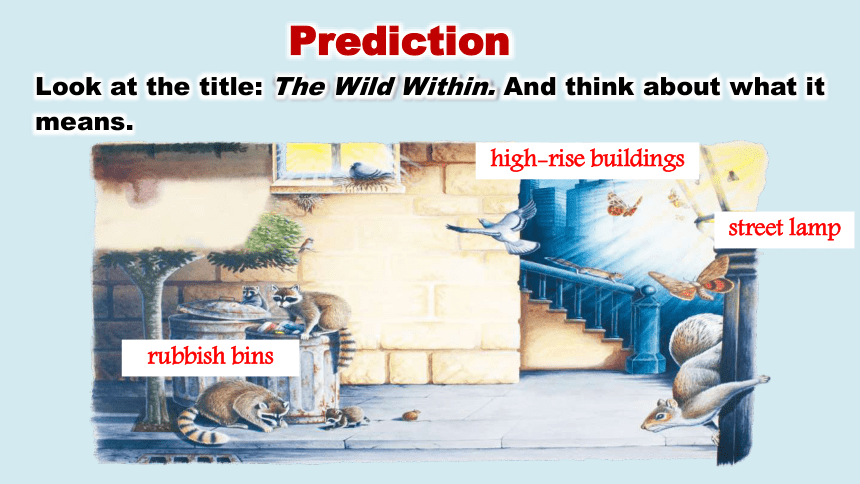
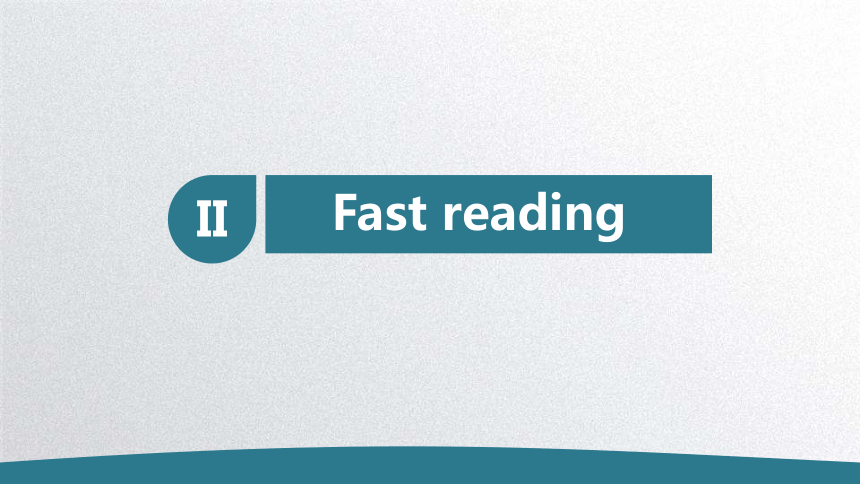

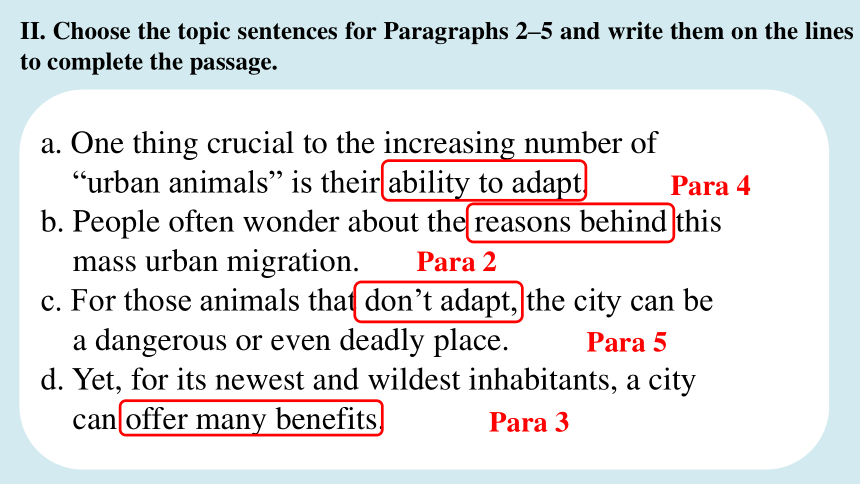
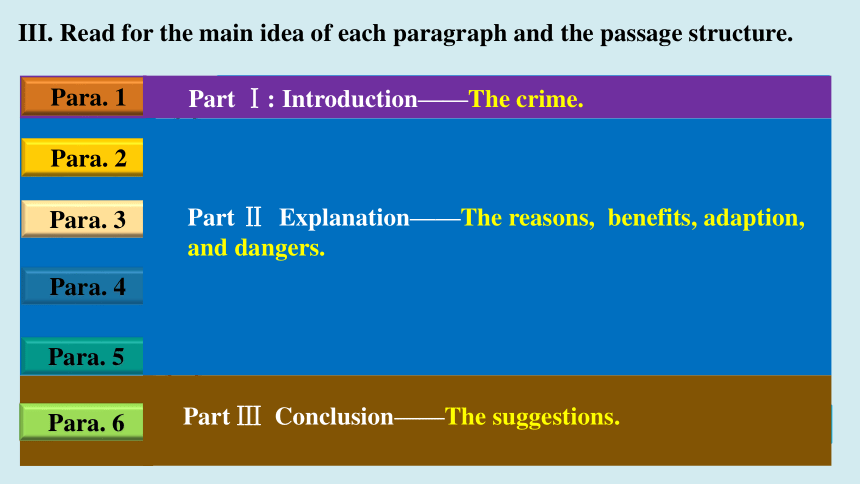

文档简介
(共64张PPT)
Unit 6 Survival
【版本:外研 册别:选择性必修二】
Understanding ideas
Learning Objectives
Get what each paragraph is about and the main idea of the passage;
Integrate the information from the passage and work out its structure;
Express opinions about urban development and wildlife protection.
Language points
Post-reading
Careful reading
Fast reading
Pre-reading
Homework
I
II
III
IV
V
VI
contents
I
Pre-reading
Look at the pictures (P82) and answer the questions.
fox/f ks/
leopard/ lep d/豹
bear/be (r)/
racoon /r ku n/
浣熊
chacma baboon
/ t km / /b bu n/南非查克玛狒狒
hedgehog
/ hed h ɡ/刺猬
1. Where would you normally expect to find these animals
In the wild, maybe in the forest.
2. Would you be surprised to see these animals in a
city Why or why not
Yeah, it is not common to see them in a city.
Not surprised at all, after all, the environment has improved a lot these years.
3. What problems could they encounter in cities
They may have difficulties finding food, shelter and mates. If people find them, they may be trapped or killed.
Prediction
Look at the title: The Wild Within. And think about what it means.
rubbish bins
high-rise buildings
street lamp
II
Fast reading
Step 1 速读——整体理解文意
Ⅰ.明文章大意
What’s the main idea of the text
A.The passage is about living with wild animals.
B.The passage is about the protection of the habitats.
C.The passage is about the wild animals’ moving into cities.
D.The passage is about the protection of wild animals.
√
II. Choose the topic sentences for Paragraphs 2–5 and write them on the lines to complete the passage.
a. One thing crucial to the increasing number of
“urban animals” is their ability to adapt.
b. People often wonder about the reasons behind this
mass urban migration.
c. For those animals that don’t adapt, the city can be
a dangerous or even deadly place.
d. Yet, for its newest and wildest inhabitants, a city
can offer many benefits.
Para 4
Para 2
Para 5
Para 3
Para. 1
Para. 3
Para. 4
Para. 6
III. Read for the main idea of each paragraph and the passage structure.
a. Reasons behind wild animals’ migration.
b. The crime in a city.
c. Benefits a city can offer to wild inhabitants.
d. How wild animals adapt to the city.
e. Dangers for those that don’t adapt.
f. What we humans should do.
Para. 2
Para. 5
Part Ⅰ: Introduction——The crime.
Part Ⅱ Explanation——The reasons, benefits, adaption, and dangers.
Part Ⅲ Conclusion——The suggestions.
Para. 2
Reasons
Para. 3
Benefits
Para. 4
Adaptation
Para. 5
Dangers
Para. 6
Suggestions
Para. 1
The crime
Introduction
Explanation
Conclusion
Exposition
What is the structure of the passage
What is the genre of the passage
Read for main idea of the passage
The passage explains the impact of human urbanization process on wildlife by introducing the phenomenon of wild animals entering the cities, the reasons behind, their living conditions and the problems encountered in the cities and so on.
III
Careful reading
Step 2 细读——深度获取细节
1.Who is to blame for stealing a bag of shopping
A.A clever fox.
B.A greedy thief.
C.A chacma baboon.
D.An ordinary criminal.
√
2.What can we infer from paragraph 3
A.Animals are attracted due to greener cities and plenty to eat there.
B.Animals move into cities and towns because they like looking for new
habitats.
C.Animals make their homes in towns and cities so we humans move into
their territory.
D.Urban development and climate change are not reasons for animals to
leave their homes.
√
3.What does the word “intelligent” in paragraph 4 mean
A.Strong. B.Clever.
C.Fierce. D.Heavy.
√
4.Why do birds crash into windows
A.Because they fly too fast.
B.Because there are too many birds.
C.Because they mistake glass for blue sky.
D.Because they have already changed their migratory routes.
√
5.What is the author’s purpose in writing the passage
A.To show his love for the wild animals.
B.To introduce the new neighbours in cities.
C.To share his experience of living with the wild animals.
D.To appeal to humans to live in harmony with the wild animals.
√
Language points
V
1. Why did the author give the example of the crime
To introduce the topic.
2. Who was the "criminal" in paragraph one
A. mountain lions B. wild pigs
C. chacma baboon D. foxes
3. What figure of speech is used in the last sentence What can it bring us?
Personification, which makes the description more vivid so that it can attract readers’ attention.
Para.1
√
The crime took place in a seaside suburb of Cape Town. Spotting the car with its window left open, the greedy thief didn’t hesitate. Within seconds, he had reached inside and run away with a bag of shopping. No matter how many crimes he committed, the police were powerless to arrest him. You see, this was no ordinary criminal: it was a chacma baboon. Once almost unheard of, scenes like this one in Cape Town are now common all over the world. With foxes in London, mountain lions in San Francisco and wild pigs in Hong Kong, it is almost as if our cities are being taken over by wild animals.
发生;举行
v. 犹豫hesitate to do sth: 犹豫做某事;不愿做某事
几秒钟之内
n. 犯罪 criminal adj. 罪犯的 n. 罪犯
v. 犯罪;承诺 commitment n. 承诺;献身
v. 吸引;逮捕 n. 逮捕;监禁
n. 罪犯
/'t km //b 'bu n/ 南非大狒狒
n. 美洲狮
野猪
占领;接管
Paras. 2—6
Para. 2 Reasons:
1.Urban development and climate change push the animals _________
__________________________________________________________.
2. With nowhere else to ______________________________________
__________________________________________________________.
out of their natural habitats
make their homes,they have no choice but to move in with us
Para. 2
People often wonder about the reasons behind this mass urban migration. Most of us would assume that urban development and climate change are responsible for pushing the animals out of their natural habitats. However true this is, we also need to consider that some of these so-called “urban animals” have never moved at all – it’s we humans who have moved into their territory. Wherever they go, animals find towns and cities in their way. With nowhere else to make their homes, they have no choice but to move in with us.
adj. 大规模的,集中的a mass of/masses of 大量的
n. 迁移, 移居 migrate v.移居 migrant n. 移居者,候鸟 adj. 移居的;流浪的
n. 领土, 版图
别无选择只能做某事
......背后的原因
Paras. 2—6
Para. 3
Para. 3 Benefits:
1.Appealing spaces as habitats.
2. Out of reach from many of their natural predators, ________________
____________________________________________________________
3. Hungry animals are _________________________________________
____________________________________________________________
these newcomers often flourish in their new city lives.
finding plenty to eat in our gardens and in the leftovers we throw away.
As our cities become greener, they offer increasingly appealing spaces to animals looking for new habitats. Out of reach from many of their natural predators, these newcomers often flourish in their new city lives. Today, foxes can be seen all over London-one even being found living on the 72nd floor of the Shard building when it was under construction! What’s more, hungry animals are finding plenty to eat in our gardens and in the leftovers we throw away.
寻找
够不着
碎片大厦
(正在)修建中
扔掉
Paras. 2—6
Para. 4
Para. 4 Adaptation:
1.Urban animals are more _______________________________.
2. Some animals have even ______________________________
_____________________________________________________
intelligent than their wild cousins
changed their living habits to fit in with their new homes.
One thing crucial to the increasing number of “urban animals” is their ability to adapt.There is evidence that urban racoons are more intelligent than their wild cousins, as they frequently have to figure out difficult problems such as how to open rubbish bins and other containers which they would not find in the wild. Some animals have even changed their living habits to fit in with their new homes. Although naturally active at night, urban foxes come out in daylight if the reward is good enough. Their city location also means
理解,弄清楚
在野外
适合;与......一致
n. 报酬;酬谢;报答 as a reward for 作为…的报酬;作为…的回报
that they are getting a taste for the multicultural cuisine on offer from the garbage, such as hamburgers, lamb kebabs and even garlic bread!
品尝;体验
adj. 多种文化的
提供的;供使用的
Paras. 2—6
Para. 5
Para. 5 Dangers:
1.Some birds crash into windows because they are unable to
______________________________________.
2.Some birds have yet to
____________________________________________________________________________________.
distinguish between blue sky and glass
change their migratory routes that take them through cities with high- rise buildings
Unable to distinguish between blue sky and glass, birds crash into windows at speeds of about 50 kilometres per hour. Recent studies estimate that between 400 million and 1 billion birds die from window impacts each year in the US alone. Shockingly, these deaths amount to around ten per cent of the total US bird population. Some species are more affected than others. One theory behind this is that these birds have yet to change their migratory routes that take them through cities with high-rise buildings.
撞上
以......的速度
死于
等同;接近;总计
百分之
n. 理论;原理
Paras. 2—6
Para. 6
Para. 6 Suggestions:
We should learn to better understand and appreciate our wild neighbours,and
____________________________________________________.
look towards harmoniously sharing our urban habitats
However they adapt to our ways of urban living, it’s important that we get a better understanding of and even learn to appreciate our wild neighbours. Only then can we look towards harmoniously sharing our urban habitats. Whatever the reasons behind these species entering our cities, one thing is for sure as it’s often a means of their survival, they could be with us to stay.
对......有更好的理解
肯定地;无疑地
一种生存方式
Unable to distinguish between blue sky and glass, birds crash into windows at speeds of about 50 kilometres per hour. Recent studies estimate that between 400 million and 1 billion birds die from window impacts each year in the US alone. Shockingly, these deaths amount to around ten per cent of the total US bird population. Some species are more affected than others. One theory behind this is that these birds have yet to change their migratory routes that take them through cities with high-rise buildings.
However they adapt to our ways of urban living, it’s important that we get a better understanding of and even learn to appreciate our wild neighbours. Only then can we look towards harmoniously sharing our urban habitats. Whatever the reasons behind these species entering our cities, one thing is for sure as it’s often a means of their survival, they could be with us to stay.
1. Why may cities be dangerous for some birds
Read and Answer
Para. 5
Para. 6
①
②
2. What should we do to coexist with our wild neibroughers
Organise information from the passage and complete the diagram.
Reasons for migration
Urban development and climate change push the animal
1______________________________.
Wherever they go, animals find towns and cities in
their way. With nowhere else to make their homes,
they have no choice but to move in with us.
2
Benefits of cities for animals
Appealing spaces as habitats.
3
Out of reach from many of their natural predators,
these newcomers often flourish in their new city lives.
4
Hungry animals are finding plenty to eat in our gardens and in the leftovers we throw away.
out of their natural habitats
Animals’ adaption
to cities
Urban animals are more
Some animals have even changed their living habits to fit in with their new homes.
6
5
Dangers
for some animals
7
Unable to distinguish between blue sky and glass, birds crash into windows.
8
Some birds have yet to change their migratory routes that take them through cities with high-rise buildings.
intelligent than their wild cousins.
We should learn to better understand and appreciate our wild neighbours, and 9
look towards harmoniously sharing our urban habitats.
Group work
Talk about what people can do to achieve a balance between the need for urban development and the protection of wild animals.
Ⅳ
Post-reading
How would you describe the relationship between people and urban animals in the passage
What figure of speech is used in the first paragraph Why does the author choose to start the passage this way
Some environmentalists argue that we should restrict urban development to leave enough natural habitats for wild animals. Do you agree with this Give your reasons.
Think Share
How would you describe the relationship between people and urban animals in the passage
Think Share
A balanced relationship. People live in the cities and some animals also see them as habitats. A harmonious relationship. People and animals can get what they need from the cities.
2. What figure of speech is used in the first paragraph Why does
the author choose to start the passage this way
Think Share
In the first paragraph, the author uses personification to describe what urban animals are doing, with the aim of attracting readers’ attention.
3. Some environmentalists argue that we should restrict urban
development to leave enough natural habitats for wild animals.
Do you agree with this Give your reasons.
Think Share
I totally agree with this idea, because we can leave some places for animals to use as habitats.
Language points
V
I’ve just spotted a mistake on the cover.
我刚才在封面上发现了一处错误。
spot sb doing sth 看到某人在做某事
I spotted someone coming out of the campus.
我看见有人从校园里走出来了。
on the spot 当场;当面;立即;马上
I can’t give you a decision on the spot.
我不能马上给你答复。
spot v 注意到;发现
Important words
I didn’t hesitate for a moment about taking the job.
我毫不犹豫地接受了那份工作。
don’t hesitate to do sth (毫无顾虑)尽管去做某事
If you have any questions, please don’t hesitate to find me. 如果你有任何问题,请尽管告诉我。
2. hesitate v 犹豫;迟疑
hesitation n 犹豫,迟疑
without hesitation 毫不犹豫地
He accepted my offer without hesitation.
他毫不犹豫地接受了我的提议。
3. flourish v 繁荣; 昌盛; 兴旺
These plants flourish in a damp climate.
这些植物在潮湿条件下长势茂盛。
Few businesses are flourishing in the present economic climate.
在目前的经济环境下,很少有企业兴旺发达。
If you are always lending a helping hand, you will someday get something as a reward.
如果你总是帮助别人,某天你可能会得到一些奖励。
4. reward n 奖励;回报;报酬
Important phases
1 commit a crime
2 take over
3 be responsible for
4 have no choice but to do sth
5 under construction
6 figure out
7 fit in with
8 get a taste for
9 distinguish between A and B
10 amount to
11 get a better understanding of
犯罪
接管
弄清楚
在建设中
为……负责
别无选择只能做某事
适应
在 A 和 B 之间区分
品尝
占……比;总计
更好地理解
Spotting the car with its window left open, the greedy thief didn’t hesitate. (P82)
Important sentences
When the greedy thief found the window of the car was open, he did what he wanted without delay / immediately.
Paraphrase 1:
spotting the car with its window left open和once almost unheard of 分别是现在分词结构和过去分词结构,均在句中作状语。
Once scenes such as this one in Cape Town were very rare, but now they are common all over the world.
Paraphrase 2:
2. Once almost unheard of, scenes like this one in Cape Town are
now common all over the world. (P82)
如何辨别什么时候用现在分词还是过去分词作状语?
关键就是看句子主语是该(非谓语动词)动作的施动者,还是该动作的承受者。
非谓语动词作状语
Entering the room, he found Jerry was seated at the desk.
主语 Jerry 和 enter 是主动关系,故用 entering。
Surrounded by a garden, this house enjoys fresh air almost all the time.
主语 this house 和 surround 是被动关系,故用 surrounded。
________ (stand) at the top of the mountain, he enjoyed a grand
sight of the city.
2) _____ (see) from the above, this house looks very small.
3) _______ (enjoy) a wonderful sight of the city, he goes to the top of the mountain.
Standing
Seen
To enjoy
主语 he 是动作 stand 的施动者
主语 this house 是动作 see 的承受者
此处用 to enjoy 表示目的
非谓语动词作状语
3. With foxes in London, mountain lions in San Francisco and
wild pigs in Hong Kong, it is almost as if our cities are being
taken over by wild animals. (P82)
Important sentences
There are foxes in London, mountain lions in San Francisco and wild pigs in Hong Kong, as if these wild animals are replacing us human beings in our cities.
Paraphrase:
with foxes in London, mountain lions in San Francisco and wild pigs in Hong Kong 为 with 的复合结构:with + 宾语 + 宾语补足语,该结构在句子中一般表示原因、伴随、条件等成分。本课中还有以下用到该结构的句子:
Spotting the car with its window left open, the greedy thief didn’t hesitate.
With nowhere else to make their homes, they have no choice but to move in with us.
with的复合结构
(1)with + 宾语(sb / sth) + doing (注:当宾语和宾补动作是主动关系时,
可以用 doing 作宾补成分)
With so many people communicating in English, English is
becoming more and more important.
此句中,宾语 people 和宾补 communicate 是主动关系,故宾补用现在
分词 communicating 的形式。
(2)with + 宾语 + done (注:当宾语和宾补是被动关系时,可以用 done 作
宾补成分)
She stood with her arms crossed, staring out the window.
此句中,宾语 her arms 和宾补 cross 是被动关系,故宾补用过去分词
crossed 的形式。
有那么多人用英语交流,英语正在变得越来越重要。
她双臂交叉站着,眼睛盯着窗外。
with的复合结构
(3)with + 宾语 +动词不定式 (注:当宾补的动作在将来发生时,
可用 to do 作宾补成分)
With a great many clothes to wash, I can’t go out now.
此句中,衣服是将来要洗,我们可以用动词不定式作宾补,故
用 to wash 的形式。
有好多衣服要洗,我现在没法出去。
with的复合结构
(4)with + 宾语 + 形容词
嘴里有东西的时候不应该说话。
You shouldn’t speak with your mouth full.
(5)with + 宾语 + 副词
他低着头站在妈妈面前。
He stood in front of his mother with his head down.
(6)with + 宾语 + 介词短语
露西眼含泪水跑开了。
Lucy ran away with tears in her eyes.
4. Only then can we look towards harmoniously sharing our
urban habitats. (P84)
Important sentences
We can expect to share our urban habitats harmoniously only at that time.
Paraphrase:
此句中,only放在句首修饰状语时,主句采用部分倒装的形式。具体形式是:only + 状语 + 助动词 + 主语 + 谓语动词 + ……
Important sentences
1) only + 副词 + 助动词 + 主语 + 谓语动词
Only then will you know the outcome. 只有到那个时候你才知道后果。
2) only + 介词短语 + 助动词 + 主语 + 谓语动词
Only in this way can you realise your dreams.
只有用这种方式,你才能实现你的梦想。
3) only + 状语从句 + 助动词 + 主语 + 谓语动词
Only when you are focused on the things can you achieve a high level of efficiency.
只有当你专心做事的时候,才能实现高效率。
1) 他只有叫喊才能让别人听到他。
Only by shouting was he able to make himself heard.
2) 只有你的身份通过验证,你才能够进去。
Only when your identity has been checked will you be allowed in.
翻译:
5. Although naturally active at night, urban foxes come out in daylight if the reward is good enough. (P83)
Important sentences
Although naturally active at night 是 although 引导的让步状语从句省略形式。
如果从句中的主语和主句中的主语一致,且从句动词含有 be 动词,就可以把状语从句中的主语和谓语的一部分或全部省略,从而使语言更加简洁。
Although urban foxes are naturally active at night, they also come out in daylight if there is a lot of food.
Paraphrase:
Important sentences
He is a good man, though sometimes (he is) rather dull.
他是个好人,尽管有时相当无聊。
2) When (she was) very young, she began to learn to play the piano.
她很小的时候,就开始学习弹钢琴。
1) 虽然他已年过八十,却比我走得快。
While (he is) over eighty, this man can walk faster than I.
2) 冰经过加热能变成水。
When (it is) heated, ice can turn into water.
翻译:
Complete the summary by filling correct words or correct forms of the given words.
More and more animals are entering cities because urban development and 1._______ change push the animals out of their 2. ______ habitats. In other words, it is we humans 3. _________ have moved into their territory and they have no choice but to move in with us. Cities actually provide some 4. ________ for the animals, such as appealing spaces as habitats, 5. _______ (be) out of reach from their natural enemies and finding plenty to eat. So some animals can adapt 6. _____ cities, who are more intelligent than their wild cousins and can find a good variety of food to eat.
climate
natural
who / that
benefits
being
to
However, some birds that can’t adjust to cities think of the city as a 7.__________ (danger) place. Unable to distinguish between blue sky and glass, they might crash 8. ______ windows. or change their migratory routes because of the high-rise buildings. From above, we should learn to 9. _______ (good) understand and appreciate our wild neighbours. Their entering our cities is a means of their 10. _________ (survive).
Complete the summary by filling correct words or correct forms of the given words.
dangerous
into
better
survival
Homework
VI
Give some suggestions that you believe are good for both urban development and wildlife conservation.
Thanks
Unit 6 Survival
【版本:外研 册别:选择性必修二】
Understanding ideas
Learning Objectives
Get what each paragraph is about and the main idea of the passage;
Integrate the information from the passage and work out its structure;
Express opinions about urban development and wildlife protection.
Language points
Post-reading
Careful reading
Fast reading
Pre-reading
Homework
I
II
III
IV
V
VI
contents
I
Pre-reading
Look at the pictures (P82) and answer the questions.
fox/f ks/
leopard/ lep d/豹
bear/be (r)/
racoon /r ku n/
浣熊
chacma baboon
/ t km / /b bu n/南非查克玛狒狒
hedgehog
/ hed h ɡ/刺猬
1. Where would you normally expect to find these animals
In the wild, maybe in the forest.
2. Would you be surprised to see these animals in a
city Why or why not
Yeah, it is not common to see them in a city.
Not surprised at all, after all, the environment has improved a lot these years.
3. What problems could they encounter in cities
They may have difficulties finding food, shelter and mates. If people find them, they may be trapped or killed.
Prediction
Look at the title: The Wild Within. And think about what it means.
rubbish bins
high-rise buildings
street lamp
II
Fast reading
Step 1 速读——整体理解文意
Ⅰ.明文章大意
What’s the main idea of the text
A.The passage is about living with wild animals.
B.The passage is about the protection of the habitats.
C.The passage is about the wild animals’ moving into cities.
D.The passage is about the protection of wild animals.
√
II. Choose the topic sentences for Paragraphs 2–5 and write them on the lines to complete the passage.
a. One thing crucial to the increasing number of
“urban animals” is their ability to adapt.
b. People often wonder about the reasons behind this
mass urban migration.
c. For those animals that don’t adapt, the city can be
a dangerous or even deadly place.
d. Yet, for its newest and wildest inhabitants, a city
can offer many benefits.
Para 4
Para 2
Para 5
Para 3
Para. 1
Para. 3
Para. 4
Para. 6
III. Read for the main idea of each paragraph and the passage structure.
a. Reasons behind wild animals’ migration.
b. The crime in a city.
c. Benefits a city can offer to wild inhabitants.
d. How wild animals adapt to the city.
e. Dangers for those that don’t adapt.
f. What we humans should do.
Para. 2
Para. 5
Part Ⅰ: Introduction——The crime.
Part Ⅱ Explanation——The reasons, benefits, adaption, and dangers.
Part Ⅲ Conclusion——The suggestions.
Para. 2
Reasons
Para. 3
Benefits
Para. 4
Adaptation
Para. 5
Dangers
Para. 6
Suggestions
Para. 1
The crime
Introduction
Explanation
Conclusion
Exposition
What is the structure of the passage
What is the genre of the passage
Read for main idea of the passage
The passage explains the impact of human urbanization process on wildlife by introducing the phenomenon of wild animals entering the cities, the reasons behind, their living conditions and the problems encountered in the cities and so on.
III
Careful reading
Step 2 细读——深度获取细节
1.Who is to blame for stealing a bag of shopping
A.A clever fox.
B.A greedy thief.
C.A chacma baboon.
D.An ordinary criminal.
√
2.What can we infer from paragraph 3
A.Animals are attracted due to greener cities and plenty to eat there.
B.Animals move into cities and towns because they like looking for new
habitats.
C.Animals make their homes in towns and cities so we humans move into
their territory.
D.Urban development and climate change are not reasons for animals to
leave their homes.
√
3.What does the word “intelligent” in paragraph 4 mean
A.Strong. B.Clever.
C.Fierce. D.Heavy.
√
4.Why do birds crash into windows
A.Because they fly too fast.
B.Because there are too many birds.
C.Because they mistake glass for blue sky.
D.Because they have already changed their migratory routes.
√
5.What is the author’s purpose in writing the passage
A.To show his love for the wild animals.
B.To introduce the new neighbours in cities.
C.To share his experience of living with the wild animals.
D.To appeal to humans to live in harmony with the wild animals.
√
Language points
V
1. Why did the author give the example of the crime
To introduce the topic.
2. Who was the "criminal" in paragraph one
A. mountain lions B. wild pigs
C. chacma baboon D. foxes
3. What figure of speech is used in the last sentence What can it bring us?
Personification, which makes the description more vivid so that it can attract readers’ attention.
Para.1
√
The crime took place in a seaside suburb of Cape Town. Spotting the car with its window left open, the greedy thief didn’t hesitate. Within seconds, he had reached inside and run away with a bag of shopping. No matter how many crimes he committed, the police were powerless to arrest him. You see, this was no ordinary criminal: it was a chacma baboon. Once almost unheard of, scenes like this one in Cape Town are now common all over the world. With foxes in London, mountain lions in San Francisco and wild pigs in Hong Kong, it is almost as if our cities are being taken over by wild animals.
发生;举行
v. 犹豫hesitate to do sth: 犹豫做某事;不愿做某事
几秒钟之内
n. 犯罪 criminal adj. 罪犯的 n. 罪犯
v. 犯罪;承诺 commitment n. 承诺;献身
v. 吸引;逮捕 n. 逮捕;监禁
n. 罪犯
/'t km //b 'bu n/ 南非大狒狒
n. 美洲狮
野猪
占领;接管
Paras. 2—6
Para. 2 Reasons:
1.Urban development and climate change push the animals _________
__________________________________________________________.
2. With nowhere else to ______________________________________
__________________________________________________________.
out of their natural habitats
make their homes,they have no choice but to move in with us
Para. 2
People often wonder about the reasons behind this mass urban migration. Most of us would assume that urban development and climate change are responsible for pushing the animals out of their natural habitats. However true this is, we also need to consider that some of these so-called “urban animals” have never moved at all – it’s we humans who have moved into their territory. Wherever they go, animals find towns and cities in their way. With nowhere else to make their homes, they have no choice but to move in with us.
adj. 大规模的,集中的a mass of/masses of 大量的
n. 迁移, 移居 migrate v.移居 migrant n. 移居者,候鸟 adj. 移居的;流浪的
n. 领土, 版图
别无选择只能做某事
......背后的原因
Paras. 2—6
Para. 3
Para. 3 Benefits:
1.Appealing spaces as habitats.
2. Out of reach from many of their natural predators, ________________
____________________________________________________________
3. Hungry animals are _________________________________________
____________________________________________________________
these newcomers often flourish in their new city lives.
finding plenty to eat in our gardens and in the leftovers we throw away.
As our cities become greener, they offer increasingly appealing spaces to animals looking for new habitats. Out of reach from many of their natural predators, these newcomers often flourish in their new city lives. Today, foxes can be seen all over London-one even being found living on the 72nd floor of the Shard building when it was under construction! What’s more, hungry animals are finding plenty to eat in our gardens and in the leftovers we throw away.
寻找
够不着
碎片大厦
(正在)修建中
扔掉
Paras. 2—6
Para. 4
Para. 4 Adaptation:
1.Urban animals are more _______________________________.
2. Some animals have even ______________________________
_____________________________________________________
intelligent than their wild cousins
changed their living habits to fit in with their new homes.
One thing crucial to the increasing number of “urban animals” is their ability to adapt.There is evidence that urban racoons are more intelligent than their wild cousins, as they frequently have to figure out difficult problems such as how to open rubbish bins and other containers which they would not find in the wild. Some animals have even changed their living habits to fit in with their new homes. Although naturally active at night, urban foxes come out in daylight if the reward is good enough. Their city location also means
理解,弄清楚
在野外
适合;与......一致
n. 报酬;酬谢;报答 as a reward for 作为…的报酬;作为…的回报
that they are getting a taste for the multicultural cuisine on offer from the garbage, such as hamburgers, lamb kebabs and even garlic bread!
品尝;体验
adj. 多种文化的
提供的;供使用的
Paras. 2—6
Para. 5
Para. 5 Dangers:
1.Some birds crash into windows because they are unable to
______________________________________.
2.Some birds have yet to
____________________________________________________________________________________.
distinguish between blue sky and glass
change their migratory routes that take them through cities with high- rise buildings
Unable to distinguish between blue sky and glass, birds crash into windows at speeds of about 50 kilometres per hour. Recent studies estimate that between 400 million and 1 billion birds die from window impacts each year in the US alone. Shockingly, these deaths amount to around ten per cent of the total US bird population. Some species are more affected than others. One theory behind this is that these birds have yet to change their migratory routes that take them through cities with high-rise buildings.
撞上
以......的速度
死于
等同;接近;总计
百分之
n. 理论;原理
Paras. 2—6
Para. 6
Para. 6 Suggestions:
We should learn to better understand and appreciate our wild neighbours,and
____________________________________________________.
look towards harmoniously sharing our urban habitats
However they adapt to our ways of urban living, it’s important that we get a better understanding of and even learn to appreciate our wild neighbours. Only then can we look towards harmoniously sharing our urban habitats. Whatever the reasons behind these species entering our cities, one thing is for sure as it’s often a means of their survival, they could be with us to stay.
对......有更好的理解
肯定地;无疑地
一种生存方式
Unable to distinguish between blue sky and glass, birds crash into windows at speeds of about 50 kilometres per hour. Recent studies estimate that between 400 million and 1 billion birds die from window impacts each year in the US alone. Shockingly, these deaths amount to around ten per cent of the total US bird population. Some species are more affected than others. One theory behind this is that these birds have yet to change their migratory routes that take them through cities with high-rise buildings.
However they adapt to our ways of urban living, it’s important that we get a better understanding of and even learn to appreciate our wild neighbours. Only then can we look towards harmoniously sharing our urban habitats. Whatever the reasons behind these species entering our cities, one thing is for sure as it’s often a means of their survival, they could be with us to stay.
1. Why may cities be dangerous for some birds
Read and Answer
Para. 5
Para. 6
①
②
2. What should we do to coexist with our wild neibroughers
Organise information from the passage and complete the diagram.
Reasons for migration
Urban development and climate change push the animal
1______________________________.
Wherever they go, animals find towns and cities in
their way. With nowhere else to make their homes,
they have no choice but to move in with us.
2
Benefits of cities for animals
Appealing spaces as habitats.
3
Out of reach from many of their natural predators,
these newcomers often flourish in their new city lives.
4
Hungry animals are finding plenty to eat in our gardens and in the leftovers we throw away.
out of their natural habitats
Animals’ adaption
to cities
Urban animals are more
Some animals have even changed their living habits to fit in with their new homes.
6
5
Dangers
for some animals
7
Unable to distinguish between blue sky and glass, birds crash into windows.
8
Some birds have yet to change their migratory routes that take them through cities with high-rise buildings.
intelligent than their wild cousins.
We should learn to better understand and appreciate our wild neighbours, and 9
look towards harmoniously sharing our urban habitats.
Group work
Talk about what people can do to achieve a balance between the need for urban development and the protection of wild animals.
Ⅳ
Post-reading
How would you describe the relationship between people and urban animals in the passage
What figure of speech is used in the first paragraph Why does the author choose to start the passage this way
Some environmentalists argue that we should restrict urban development to leave enough natural habitats for wild animals. Do you agree with this Give your reasons.
Think Share
How would you describe the relationship between people and urban animals in the passage
Think Share
A balanced relationship. People live in the cities and some animals also see them as habitats. A harmonious relationship. People and animals can get what they need from the cities.
2. What figure of speech is used in the first paragraph Why does
the author choose to start the passage this way
Think Share
In the first paragraph, the author uses personification to describe what urban animals are doing, with the aim of attracting readers’ attention.
3. Some environmentalists argue that we should restrict urban
development to leave enough natural habitats for wild animals.
Do you agree with this Give your reasons.
Think Share
I totally agree with this idea, because we can leave some places for animals to use as habitats.
Language points
V
I’ve just spotted a mistake on the cover.
我刚才在封面上发现了一处错误。
spot sb doing sth 看到某人在做某事
I spotted someone coming out of the campus.
我看见有人从校园里走出来了。
on the spot 当场;当面;立即;马上
I can’t give you a decision on the spot.
我不能马上给你答复。
spot v 注意到;发现
Important words
I didn’t hesitate for a moment about taking the job.
我毫不犹豫地接受了那份工作。
don’t hesitate to do sth (毫无顾虑)尽管去做某事
If you have any questions, please don’t hesitate to find me. 如果你有任何问题,请尽管告诉我。
2. hesitate v 犹豫;迟疑
hesitation n 犹豫,迟疑
without hesitation 毫不犹豫地
He accepted my offer without hesitation.
他毫不犹豫地接受了我的提议。
3. flourish v 繁荣; 昌盛; 兴旺
These plants flourish in a damp climate.
这些植物在潮湿条件下长势茂盛。
Few businesses are flourishing in the present economic climate.
在目前的经济环境下,很少有企业兴旺发达。
If you are always lending a helping hand, you will someday get something as a reward.
如果你总是帮助别人,某天你可能会得到一些奖励。
4. reward n 奖励;回报;报酬
Important phases
1 commit a crime
2 take over
3 be responsible for
4 have no choice but to do sth
5 under construction
6 figure out
7 fit in with
8 get a taste for
9 distinguish between A and B
10 amount to
11 get a better understanding of
犯罪
接管
弄清楚
在建设中
为……负责
别无选择只能做某事
适应
在 A 和 B 之间区分
品尝
占……比;总计
更好地理解
Spotting the car with its window left open, the greedy thief didn’t hesitate. (P82)
Important sentences
When the greedy thief found the window of the car was open, he did what he wanted without delay / immediately.
Paraphrase 1:
spotting the car with its window left open和once almost unheard of 分别是现在分词结构和过去分词结构,均在句中作状语。
Once scenes such as this one in Cape Town were very rare, but now they are common all over the world.
Paraphrase 2:
2. Once almost unheard of, scenes like this one in Cape Town are
now common all over the world. (P82)
如何辨别什么时候用现在分词还是过去分词作状语?
关键就是看句子主语是该(非谓语动词)动作的施动者,还是该动作的承受者。
非谓语动词作状语
Entering the room, he found Jerry was seated at the desk.
主语 Jerry 和 enter 是主动关系,故用 entering。
Surrounded by a garden, this house enjoys fresh air almost all the time.
主语 this house 和 surround 是被动关系,故用 surrounded。
________ (stand) at the top of the mountain, he enjoyed a grand
sight of the city.
2) _____ (see) from the above, this house looks very small.
3) _______ (enjoy) a wonderful sight of the city, he goes to the top of the mountain.
Standing
Seen
To enjoy
主语 he 是动作 stand 的施动者
主语 this house 是动作 see 的承受者
此处用 to enjoy 表示目的
非谓语动词作状语
3. With foxes in London, mountain lions in San Francisco and
wild pigs in Hong Kong, it is almost as if our cities are being
taken over by wild animals. (P82)
Important sentences
There are foxes in London, mountain lions in San Francisco and wild pigs in Hong Kong, as if these wild animals are replacing us human beings in our cities.
Paraphrase:
with foxes in London, mountain lions in San Francisco and wild pigs in Hong Kong 为 with 的复合结构:with + 宾语 + 宾语补足语,该结构在句子中一般表示原因、伴随、条件等成分。本课中还有以下用到该结构的句子:
Spotting the car with its window left open, the greedy thief didn’t hesitate.
With nowhere else to make their homes, they have no choice but to move in with us.
with的复合结构
(1)with + 宾语(sb / sth) + doing (注:当宾语和宾补动作是主动关系时,
可以用 doing 作宾补成分)
With so many people communicating in English, English is
becoming more and more important.
此句中,宾语 people 和宾补 communicate 是主动关系,故宾补用现在
分词 communicating 的形式。
(2)with + 宾语 + done (注:当宾语和宾补是被动关系时,可以用 done 作
宾补成分)
She stood with her arms crossed, staring out the window.
此句中,宾语 her arms 和宾补 cross 是被动关系,故宾补用过去分词
crossed 的形式。
有那么多人用英语交流,英语正在变得越来越重要。
她双臂交叉站着,眼睛盯着窗外。
with的复合结构
(3)with + 宾语 +动词不定式 (注:当宾补的动作在将来发生时,
可用 to do 作宾补成分)
With a great many clothes to wash, I can’t go out now.
此句中,衣服是将来要洗,我们可以用动词不定式作宾补,故
用 to wash 的形式。
有好多衣服要洗,我现在没法出去。
with的复合结构
(4)with + 宾语 + 形容词
嘴里有东西的时候不应该说话。
You shouldn’t speak with your mouth full.
(5)with + 宾语 + 副词
他低着头站在妈妈面前。
He stood in front of his mother with his head down.
(6)with + 宾语 + 介词短语
露西眼含泪水跑开了。
Lucy ran away with tears in her eyes.
4. Only then can we look towards harmoniously sharing our
urban habitats. (P84)
Important sentences
We can expect to share our urban habitats harmoniously only at that time.
Paraphrase:
此句中,only放在句首修饰状语时,主句采用部分倒装的形式。具体形式是:only + 状语 + 助动词 + 主语 + 谓语动词 + ……
Important sentences
1) only + 副词 + 助动词 + 主语 + 谓语动词
Only then will you know the outcome. 只有到那个时候你才知道后果。
2) only + 介词短语 + 助动词 + 主语 + 谓语动词
Only in this way can you realise your dreams.
只有用这种方式,你才能实现你的梦想。
3) only + 状语从句 + 助动词 + 主语 + 谓语动词
Only when you are focused on the things can you achieve a high level of efficiency.
只有当你专心做事的时候,才能实现高效率。
1) 他只有叫喊才能让别人听到他。
Only by shouting was he able to make himself heard.
2) 只有你的身份通过验证,你才能够进去。
Only when your identity has been checked will you be allowed in.
翻译:
5. Although naturally active at night, urban foxes come out in daylight if the reward is good enough. (P83)
Important sentences
Although naturally active at night 是 although 引导的让步状语从句省略形式。
如果从句中的主语和主句中的主语一致,且从句动词含有 be 动词,就可以把状语从句中的主语和谓语的一部分或全部省略,从而使语言更加简洁。
Although urban foxes are naturally active at night, they also come out in daylight if there is a lot of food.
Paraphrase:
Important sentences
He is a good man, though sometimes (he is) rather dull.
他是个好人,尽管有时相当无聊。
2) When (she was) very young, she began to learn to play the piano.
她很小的时候,就开始学习弹钢琴。
1) 虽然他已年过八十,却比我走得快。
While (he is) over eighty, this man can walk faster than I.
2) 冰经过加热能变成水。
When (it is) heated, ice can turn into water.
翻译:
Complete the summary by filling correct words or correct forms of the given words.
More and more animals are entering cities because urban development and 1._______ change push the animals out of their 2. ______ habitats. In other words, it is we humans 3. _________ have moved into their territory and they have no choice but to move in with us. Cities actually provide some 4. ________ for the animals, such as appealing spaces as habitats, 5. _______ (be) out of reach from their natural enemies and finding plenty to eat. So some animals can adapt 6. _____ cities, who are more intelligent than their wild cousins and can find a good variety of food to eat.
climate
natural
who / that
benefits
being
to
However, some birds that can’t adjust to cities think of the city as a 7.__________ (danger) place. Unable to distinguish between blue sky and glass, they might crash 8. ______ windows. or change their migratory routes because of the high-rise buildings. From above, we should learn to 9. _______ (good) understand and appreciate our wild neighbours. Their entering our cities is a means of their 10. _________ (survive).
Complete the summary by filling correct words or correct forms of the given words.
dangerous
into
better
survival
Homework
VI
Give some suggestions that you believe are good for both urban development and wildlife conservation.
Thanks
